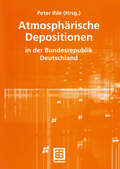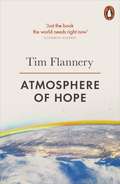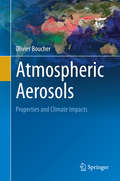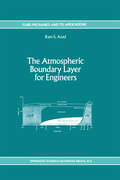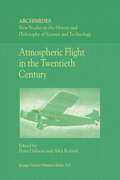- Table View
- List View
Atmosphärische Depositionen in der Bundesrepublik Deutschland (Schriftenreihe des Instituts für Energetik und Umwelt)
by Peter IhleDas Institut für Energetik und Umwelt, Leipzig, betreut im Auftrag des Umweltbundesamtes seit 1991 das Messnetz des Bundes, das von Helgoland bis in die Alpen reicht. Eine Fülle von Daten ist in diesem Zeitraum gesammelt worden, die in diesem Buch zusammengefasst und bewertet der Öffentlichkeit zugänglich gemacht werden.
Atmosphere and Climate: Studies by Occultation Methods
by Ulrich Foelsche Gottfried Kirchengast Andrea SteinerThis book presents carefully edited and peer-reviewed papers from the 2nd International Workshop on Occultations for Probing Atmosphere and Climate (OPAC-2), held in Graz, Austria. It starts with a general introductory paper and proceeds to address the full range from methodology in general via specific occultation methods (GNSS-LEO, LEO-LEO, stellar and solar) to the use of occultation data, with focus on atmospheric physics, meteorology and climate.
Atmosphere in Space Cabins and Closed Environments
by Karl KammermeyerMANNED SPACE FLIGHT introduces into space travel parameters that are unique. Man can live without food for a reasonably long period; without water, the period becomes quite a bit shorter; but without air, the result-almost instantaneous-is death. This would make the atmosphere the most important consideration. In fact, however, man needs all three components: oxygen, water, and food; and if anyone of them failS, he is doomed. With our space efforts approaching trips of several weeks in length and certainly heading for month-long journeys, it is most appropriate to ask: Are we ready to provide an adequate atmo spheric milieu for the astronauts? The present volume represents the first integrated attempt to answer this question on a scientific level and on a broad basis of physical and mechanical, biological, biochemical and medical factors. The main features of this work were presented at a symposium of the Division of Industrial and Engineering Chemistry of the American Chemical Society, held in Atlantic City on Septem ber 13, 1965. The volume is an expanded and reorganized treatise based on, but not merely proceeding from, the symposium. Obviously, medical aspects are of paramount importance. A down-to-earth appraisal of the status quo, presented by Dr. E. M. Roth, shows that the problem of 100% oxygen atmosphere still is beset with some uncertainty in the 200 to 500 mm. total cabin pressure range. Additionally, attention is called to inherent dangers of greatly increased flammability in such an atmosphere.
Atmosphere of Hope: Solutions to the Climate Crisis
by Tim FlanneryA timely intervention on climate change from the internationally acclaimed scientist and author of the hugely influential The Weather Makers.How close is the great climate crisis? Can our desire to overcome it drive humanity's next great waves of positive technological economic and social revolution? or will we be plunged into the dystopian collapses and terrors of civilisations past?This book describes in plain terms our climate predicament and brings news of exciting tools in the making that could help us avoid a climatic disaster. In December 2015 the nations of the world will gather in Paris to try to forge a climate treaty designed to give us a fighting chance to limit global warming to 2°C, widely regarded as the safe upper limit if we are to avoid catastrophe. If we succeed at Paris, forging a new era of international political cooperation in the fight against a warming planet, it is possible that the next decade will astonish us in the solutions that we discover to safeguard our planet for our grandchildren and their grandchildren.'Think Indiana Jones crossed with Charles Darwin' Financial Times'A wonderful writer, an original scientist, and a gifted populariser' Martin Woollacott, Guardian'If you're not already addicted to Tim Flannery's writing, discover him now' Jared Diamond
Atmospheres and Oceans on Computers: Fundamental Numerical Methods for Geophysical Fluid Dynamics (Springer Textbooks in Earth Sciences, Geography and Environment)
by Lars Petter RøedThis textbook introduces step by step the basic numerical methods to solve the equations governing the motion of the atmosphere and ocean, and describes how to develop a set of corresponding instructions for the computer as part of a code. Today's computers are powerful enough to allow 7-day forecasts within hours, and modern teaching of the subject requires a combination of theoretical and computational approaches. The presentation is aimed at beginning graduate students intending to become forecasters or researchers, that is, users of existing models or model developers. However, model developers must be well versed in the underlying physics as well as in numerical methods. Thus, while some of the topics discussed in the modeling of the atmosphere and ocean are more advanced, the book ensures that the gap between those scientists who analyze results from model simulations and observations and those who work with the inner works of the model does not widen further. In this spirit, the course presents methods whereby important balance equations in oceanography and meteorology, namely the advection-diffusion equation and the shallow water equations on a rotating Earth, can be solved by numerical means with little prior knowledge. The numerical focus is on the finite-difference (FD) methods, and although more powerful methods exist, the simplicity of FD makes it ideal as a pedagogical introduction to the subject. The book also includes suitable exercises and computer problems.
Atmospheric Aerosol Properties: Formation, Processes and Impacts (Springer Praxis Books)
by Kirill Ya. Kondratyev Lev S. Ivlev Vladimir F. Krapivin Costas A. VarostosThis book provides the first comprehensive analysis of how aerosols form in the atmosphere through in situ processes as well as via transport from the surface (dust storms, seas spray, biogenic emissions, forest fires etc.). Such an analysis has been followed by the consideration of both observation data (various field observational experiments) and numerical modeling results to assess climate impacts of aerosols bearing in mind that these impacts are the most significant uncertainty in studying natural and anthropogenic causes of climate change.
Atmospheric Aerosols: Properties and Climate Impacts (Springer Atmospheric Sciences Ser.)
by Olivier BoucherThis textbook aims to be a one stop shop for those interested in aerosols and their impact on the climate system. It starts with some fundamentals on atmospheric aerosols, atmospheric radiation and cloud physics, then goes into techniques used for in-situ and remote sensing measurements of aerosols, data assimilation, and discusses aerosol-radiation interactions, aerosol-cloud interactions and the multiple impacts of aerosols on the climate system. The book aims to engage those interested in aerosols and their impacts on the climate system: graduate and PhD students, but also post-doctorate fellows who are new to the field or would like to broaden their knowledge. The book includes exercises at the end of most chapters.Atmospheric aerosols are small (microscopic) particles in suspension in the atmosphere, which play multiple roles in the climate system. They interact with the energy budget through scattering and absorption of solar and terrestrial radiation. They also serve as cloud condensation and ice nuclei with impacts on the formation, evolution and properties of clouds. Finally aerosols also interact with some biogeochemical cycles. Anthropogenic emissions of aerosols are responsible for a cooling effect that has masked part of the warming due to the increased greenhouse effect since pre-industrial time. Natural aerosols also respond to climate changes as shown by observations of past climates and modelling of the future climate.
Atmospheric and Space Flight Dynamics: Modeling and Simulation with MATLAB® and Simulink® (Modeling and Simulation in Science, Engineering and Technology)
by Ashish TewariThis book offers a unified presentation that does not discriminate between atmospheric and space flight. It demonstrates that the two disciplines have evolved from the same set of physical principles and introduces a broad range of critical concepts in an accessible, yet mathematically rigorous presentation. The book presents many MATLAB and Simulink-based numerical examples and real-world simulations. Replete with illustrations, end-of-chapter exercises, and selected solutions, the work is primarily useful as a textbook for advanced undergraduate and beginning graduate-level students.
The Atmospheric Boundary Layer for Engineers (Fluid Mechanics and Its Applications #17)
by R. S. AzadWhile I was participating in the IUTAM Symposium on Structure of Turbulence and Drag Reduction in Zurich, Switzerland, in 1989, I was approached by Prof. Dr. Themistocles Dracos to give a course oflectures on the Atmospheric Boundary Layer during my sabbatical leave at Eidgenossische Technische Hochschule (ETH) Zurich - Hoenggerberg in 1991. His reason for the suggestion was the growing interest in the environment and its dynamics created by flow in the Atmospheric Boundary Layer. I have been teaching boundary layer to undergraduate and graduate students for more than twenty five years, so I agreed to give a series of lectures on boundary layer of the atmosphere. From the start I thought very seriously about the problem and consulted all the published works in English on the Atmospheric Boundary Layer (ABL). First consider the topography of the Earth which has oceans calm and turbulent, mountain ranges of height up to 9 km, lands of variable height with forests, food growing vegetable and deserts. The shape of the Earth is nearly spherical except at the north and south poles. Sun supplies the energy to drive circulation of air around the Earth's atmosphere which for all practical purposes occupies the region up to about 10 to 11 km. This brief scenerio of Earth's topography reveals the complexity of flow very close to the Earth's surface that is hardly flat except at the oceans' surface which consists of about 70% of the total Earth's surface.
Atmospheric Boundary Layers: Nature, Theory, and Application to Environmental Modelling and Security
by A. Baklanov B. Grisogono Alexander Baklanov Branko GrisogonoThis volume presents peer-reviewed papers from the NATO Advanced Research Workshop on Atmospheric Boundary Layers held in April 2006. The papers are divided into thematic sessions: nature and theory of turbulent boundary layers; boundary-layer flows: modeling and applications to environmental security; nature, theory and modeling of boundary-layer flows; air flows within and above urban and other complex canopies: air-sea-ice interaction.
Atmospheric Convection: Research and Operational Forecasting Aspects (CISM International Centre for Mechanical Sciences #475)
by Dario B. Giaiotti Reinhold Steinacker Fulvio StelThis book treats atmospheric convection from different angles including the theoretical aspects of atmospheric deep convection and the weather phenomena related to convection. The problem of boundary conditions that result in severe convective weather patterns is explored within the framework of worldwide climatology. The book bridges the gap between theory and its operational application both within the fields of weather forecasting and that of risk management.
Atmospheric Deposition and Forest Nutrient Cycling: A Synthesis of the Integrated Forest Study (Ecological Studies #91)
by Dale W. Johnson Steven E. LindbergOver the past decade there has been considerable interest in the effects of atmospheric deposition on forest ecosystems. This volume summarizes the results of the Integrated Forest Study (IFS), one of the most comprehensive research programs conducted. It involved intensive measurements of deposition and nutrient cycling at seventeen diverse forested sites in the United States, Canada, and Norway. The IFS is unique as an applied research project in its complete, ecosystem-level evaluation of nutrient budgets, including significant inputs, outputs, and internal fluxes. It is also noteworthy as a more basic investigation of ecosystem nutrient cycling because of its incorporation of state-of-the-art methods, such as quantifying dry and cloud water deposition. Most significantly, the IFS data was used to test several general hypotheses regarding atmospheric deposition and its effects. The data sets also allow for far-reaching conclusions because all sites were monitored over the same period using comparable instruments and standardized protocols.
Atmospheric Dispersion of Heavy Gases and Small Particles: Symposium, Delft, The Netherlands August 29 – September 2, 1983 (IUTAM Symposia)
by H Tennekes G. OomsAtmospheric Effects in Space Geodesy (Springer Atmospheric Sciences)
by Johannes Böhm and Harald SchuhVarious effects of the atmosphere have to be considered in space geodesy and all of them are described and treated consistently in this textbook. Two chapters are concerned with ionospheric and tropospheric path delays of microwave and optical signals used by space geodetic techniques, such as the Global Navigation Satellite Systems (GNSS), Very Long Baseline Interferometry (VLBI), or Satellite Laser Ranging (SLR). It is explained how these effects are best reduced and modelled to improve the accuracy of space geodetic measurements. Other chapters are on the deformation of the Earth’s crust due to atmospheric loading, on atmospheric excitation of Earth rotation, and on atmospheric effects on gravity field measurements from special satellite missions such as CHAMP, GRACE, and GOCE. All chapters have been written by staff members of the Department of Geodesy and Geoinformation at TU Wien who are experts in the particular fields.
Atmospheric Environmental Research: Critical Decisions Between Technological Progress and Preservation of Nature
by DetlevMöllerThis is an extended version of lectures that were held at the summer workshop Atmosphiirische Umweltforschung im Spannungsfeld zwischen Technik und Natur (At mospheric Environmental Research between Technology and Nature) at the Techni 16, 1996. We were very happy to have Paul J. Crutzen, cal University in Cottbus on July winner of the Nobel Prize for chemistry in 1995, presenting the key lecture on glo bally changing chemistry in the atmosphere. Over the last decades, atmospheric chem istry has been established step by step, not just as an applied discipline of chemistry, but also as a key discipline for our understanding of air pollution, biogeochemical cycling, and climactic processes as well. In fact, the new definition of meteorology as the science of physics and chemistry of the atmosphere expresses this development very well. The chemistry of the atmosphere is strongly influenced by anthropogenic emissions, even on a global scale. As a result of emissions and chemical reactions, the chemical composition of the atmosphere influences the ecosystems directly via depo sition of trace substances, and indirectly by changing the physical climate. Therefore, in this book we combined state-of-the-art lectures describing the physical and chemi cal status of the atmosphere and selected issues representing the interface between atmosphere, technology and nature. Oxidising capacity, heterogeneous processes and acidity still remain as key issues in atmospheric chemistry, even in regions where efficient air control measures have been adopted resulting in reduction of primary atmospheric pollutants.
Atmospheric Flight in the Twentieth Century (Archimedes #3)
by Alex Roland, Peter GalisonAll technologies differ from one another. They are as varied as humanity's interaction with the physical world. Even people attempting to do the same thing produce multiple technologies. For example, John H. White discovered more than l 1000 patents in the 19th century for locomotive smokestacks. Yet all technologies are processes by which humans seek to control their physical environment and bend nature to their purposes. All technologies are alike. The tension between likeness and difference runs through this collection of papers. All focus on atmospheric flight, a twentieth-century phenomenon. But they approach the topic from different disciplinary perspectives. They ask disparate questions. And they work from distinct agendas. Collectively they help to explain what is different about aviation - how it differs from other technologies and how flight itself has varied from one time and place to another. The importance of this topic is manifest. Flight is one of the defining technologies of the twentieth century. Jay David Bolter argues in Turing's Man that certain technologies in certain ages have had the power not only to transform society but also to shape the way in which people understand their relationship with the physical world. "A defining technology," says Bolter, "resembles a magnifying glass, which collects and focuses seemingly disparate ideas in a culture into one bright, sometimes piercing ray." 2 Flight has done that for the twentieth century.
Atmospheric Icing of Power Networks
by Masoud FarzanehAtmospheric ice takes a wide range of fascinating forms, all beautiful in their own ways but many posing severe risk to the security of overhead networks for electric power, communications and other systems. This comprehensive book documents the fundamentals of atmospheric icing and surveys the state of the art in eight chapters, each written by a team of experienced and internationally renowned experts. The treatment is detailed and richly illustrated. The presentation follows a logical sequence, starting with the icing climate and meteorological conditions, proceeding through development of observations and models of accretion and release of ice and heavy snow, then considering static and dynamic mechanical loads, the effects of ice and snow on electrical insulation, de-icing, ice prevention and mitigation methods. The statistical analysis of icing data and the mathematical and numerical modelling support appropriate mechanical and electrical design processes for icing conditions on overhead lines. Technical specialists, researchers and students in engineering and environmental science will all find value throughout the text.
Atmospheric Methane: Its Role in the Global Environment
by Mohammad Aslam Khan KhalilMethane is an important greenhouse gas that can cause global warming. The present concentrations of methane are nearly three times higher than several hundred years ago. Today, more than 60% of the atmospheric methane comes from human activities, including rice agriculture, coal mining, natural gas usage, biomass burning, and raising of cattle. Methane affects the stratospheric ozone layer and the oxidizing capacity of the atmosphere, which in turn control the concentrations of many man-made and natural gases in the atmosphere. This book brings together our knowledge of the trends and the causes behind the increased levels of methane. Based on the scientific information on the sources and sinks, and the role of methane in global warming, strategies to limit emissions can be designed as part of a program to control future global warming.
Atmospheric Methane: Sources, Sinks, and Role in Global Change (Nato ASI Subseries I: #13)
by M. A. K. KhalilMethane plays many important roles in the earth's environment. It is a potent "greenhouse gas" that warms the earth; controls the oxidizing capacity of the atmosphere (OH) indirectly affecting the cycles and abundances of many atmospheric trace gases; provides water vapor to the stratosphere; scavenges chlorine atoms from the stratosphere, terminating the catalytic ozone destruction by chlorine atoms, including the chlorine released from the man-made chlorofluorocarbons; produces ozone, CO, and CO2 in the troposphere; and it is an index of life on earth and so is present in greater quantities during warm interglacial epochs and dwindles to low levels during the cold of ice ages. By all measures, methane is the second only to CO2 in causing future global warming. The book presents a comprehensive account of the current understanding of atmospheric methane, and it is an end point for summarizing more than a decade of intensive research on the global sources, sinks, concentrations, and environmental role of methane.
Atmospheric Nuclear Tests: Environmental and Human Consequences (Nato Science Partnership Subseries: 2 #35)
by Charles S. ShapiroRadionuclides produced by past nuclear weapon test explosions comprise the largest source of anthropogenic radioactivity released into the earth's atmosphere to date. This volume presents data and models about the fate of the released radionuclides and their possible effects on human health. It is divided into the following three parts: - Source Term Studies;- Dose Reconstruction;- Ecological and Health Effects,and comprises both Western and formerly secret Soviet research studies, illuminates past and current research.
Atmospheric Ozone Dynamics: Observations in the Mediterranean Region (Nato ASI Subseries I: #53)
by Costas VarotsosAn increasing allllo~/allce because of the anthropogenically induced ozone depletion and relevant illcrca5e of the surface ultraviolet (UV) radiation (including erythemal part of the UV spectrum) has resulted in the growth of interest to total ozone (TOZ) surface and satellite observations, surface UV measurements (with an emphasis on UV -B) and. the interpretation of observation results to assess potential impacts of the UV radiation enhancement on man and biosphere. The significance of this phenomenon is diJIcrent in various cowltries. Special attention has been paid, for instance, to ozone depletion and UV radiation increase at high latitudes (this problem has also been discussed during the Workshop). It is equally clear, however, that low and mid-latitude environmental dynamics requires carefuU monitoring and assessment of environm(:ntal trends as well. Such a conclusion is especially true for the Mediterranean Region where numerous resort places are located and subject to excessive levels of Solar Ultraviolet Radiation. This is why the NATO Advanced Rcsearch Workshop "Ground-Level and Satellite Ozone Observations: Changes in the Mediterranean Region" was organized and took place in Athens (Grcccc) during the Lime period 31 October -4 November 1995. It should be pointed out, however, that presentations discussed during the Workshop went far beyond the regional scale of consideration. This has been very important, because it opened an opportwlity to analyse the Mediterrane:an environmental situation in the broader contcx1 of the European global changes.
Atmospheric Physics: Background – Methods – Trends (Research Topics in Aerospace)
by Ulrich SchumannOn the occasion of the 50th anniversary of the Institute of Atmospheric Physics of the German Aerospace Center (DLR), this book presents more than 50 chapters highlighting results of the institute’s research.The book provides an up-to-date, in-depth survey across the entire field of atmospheric science, including atmospheric dynamics, radiation, cloud physics, chemistry, climate, numerical simulation, remote sensing, instruments and measurements, as well as atmospheric acoustics.The authors have provided a readily comprehensible and self-contained presentation of the complex field of atmospheric science. The topics are of direct relevance for aerospace science and technology. Future research challenges are identified.
Atmospheric Pressure Plasma for Surface Modification
by Rory A. WolfThis Book’s focus and intent is to impart an understanding of the practical application of atmospheric plasma for the advancement of a wide range of current and emerging technologies. The primary key feature of this book is the introduction of over thirteen years of practical experimental evidence of successful surface modifications by atmospheric plasma methods. It offers a handbook-based approach for leveraging and optimizing atmospheric plasma technologies which are currently in commercial use. It also offers a complete treatment of both basic plasma physics and industrial plasma processing with the intention of becoming a primary reference for students and professionals. The reader will learn the mechanisms which control and operate atmospheric plasma technologies and how these technologies can be leveraged to develop in-line continuous processing of a wide variety of substrates. Readers will gain an understanding of specific surface modification effects by atmospheric plasmas, and how to best characterize those modifications to optimize surface cleaning and functionalization for adhesion promotion. The book also features a series of chapters written to address practical surface modification effects of atmospheric plasmas within specific application markets, and a commercially-focused assessment of those effects.
Atmospheric Pressure Plasma for Surface Modification
by Rory A. WolfThis Book’s focus and intent is to impart an understanding of the practical application of atmospheric plasma for the advancement of a wide range of current and emerging technologies. The primary key feature of this book is the introduction of over thirteen years of practical experimental evidence of successful surface modifications by atmospheric plasma methods. It offers a handbook-based approach for leveraging and optimizing atmospheric plasma technologies which are currently in commercial use. It also offers a complete treatment of both basic plasma physics and industrial plasma processing with the intention of becoming a primary reference for students and professionals. The reader will learn the mechanisms which control and operate atmospheric plasma technologies and how these technologies can be leveraged to develop in-line continuous processing of a wide variety of substrates. Readers will gain an understanding of specific surface modification effects by atmospheric plasmas, and how to best characterize those modifications to optimize surface cleaning and functionalization for adhesion promotion. The book also features a series of chapters written to address practical surface modification effects of atmospheric plasmas within specific application markets, and a commercially-focused assessment of those effects.
Atmospheric Pressure Plasma Treatment of Polymers: Relevance to Adhesion (Adhesion and Adhesives: Fundamental and Applied Aspects)
by Michael Thomas K. L. MittalThe Atmospheric Pressure Plasma (APP) treatment for polymer surface modification has attracted much attention recently, owing to its advantages over other techniques and its ability to improve adhesion without tampering with polymer's bulk properties. Focusing on the utility of APP treatment for enhancing polymer adhesion, this book covers the latest development in this important and enabling technology, providing profound insights from many top researchers on the design and functions of various types of reactors, as well as current and potential applications of APP treatment.
